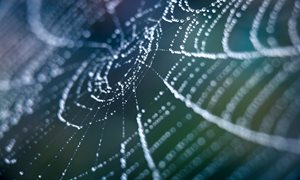25 October 2018
Henssen: “We came upon this idea because we were noticing that some patients with nerve pain responded more poorly to treatment in the brain than others. We didn’t find anything about it in the literature on the human brain, but we did discover that this type of left-right branching had already been described for various types of animals, including mice, rats, frogs, and different ape species. That served as the impetus for us to continue searching for the possibility of a similar branching in the human brain.”
The reason why researchers had not noticed this previously was primarily because Henssen and his colleagues used a unique microscopy technique which assisted them in imaging and understanding the structure of the brain better. This technique, called polarized light imaging (PLI), uses polarized light to display patterns in brain tissue that cannot be detected with standard microscopes.
Henssen: “This really is a special discovery, because it has actually been about a hundred years since a truly new neural pathway was found in the human brain. But also because I hope that this discovery will usher in better treatment options for those suffering from facial pain.” Henssen is still very cautious when raising that last point: “We are currently conducting follow-up experiments, but I cannot say much about the results at this point in time. Pain is not high on the scientific or political agenda, but it is slowly attracting more and more attention, fortunately.
Read the full article on this finding here.
 Researchers at Radboudumc have discovered a new neural pathway in the human brain by using various imaging techniques. This discovery may have an impact on the treatment of facial pain and other issues.
Researchers at Radboudumc have discovered a new neural pathway in the human brain by using various imaging techniques. This discovery may have an impact on the treatment of facial pain and other issues.
Henssen: “We came upon this idea because we were noticing that some patients with nerve pain responded more poorly to treatment in the brain than others. We didn’t find anything about it in the literature on the human brain, but we did discover that this type of left-right branching had already been described for various types of animals, including mice, rats, frogs, and different ape species. That served as the impetus for us to continue searching for the possibility of a similar branching in the human brain.”
Driving right past it
Using powerful MRI scanners and special microscopic research methods, they succeeded in verifying the existence of the new neural pathway in deceased human beings. This neural pathway branches off from the facial nerve - a nerve which originates in the brainstem. “That is the nerve which may cause issues for those suffering from facial pain,” says Henssen. “By scanning the brainstems of the deceased and then conducting research using the microscope, we saw that, in contrast to the anticipated single split, the nerve actually branched off in two directions.”The reason why researchers had not noticed this previously was primarily because Henssen and his colleagues used a unique microscopy technique which assisted them in imaging and understanding the structure of the brain better. This technique, called polarized light imaging (PLI), uses polarized light to display patterns in brain tissue that cannot be detected with standard microscopes.
Unique discovery
PLI was developed in the German city of Jülich. The Anatomy division at Radboudumc is the only department in the Netherlands that has PLI at its disposal, because the Van Cappellen-Van Walsum research group collaborated with Oxford, where PLI had already been in use for some time. Henssen became skilled in applying the technique in Jülich and along with the German research team, the Nijmegen researchers have now arrived at this conclusion.Henssen: “This really is a special discovery, because it has actually been about a hundred years since a truly new neural pathway was found in the human brain. But also because I hope that this discovery will usher in better treatment options for those suffering from facial pain.” Henssen is still very cautious when raising that last point: “We are currently conducting follow-up experiments, but I cannot say much about the results at this point in time. Pain is not high on the scientific or political agenda, but it is slowly attracting more and more attention, fortunately.
Read the full article on this finding here.
Related news items

Brain connectivity as biomarker for Parkinson's disease
24 February 2022 Changes in the dopaminergic system have been implicated in various neurological and psychiatric conditions including Parkinson’s disease. The current study is the first to enable the fMRI-based study of dopamine-specific projections in the human brain, thereby providing improved diagnostics. read more
1.5 million euro grant for research into earlier recognition of Parkinson's disease
27 October 2021 Researchers aim to improve identification of early symptoms and subtypes of Parkinson's disease with large international study read more
Gatsby Foundation donates 10 million to improve Parkinson's care UK foundation supports rigorous healthcare innovation in the Netherlands
15 August 2018 The Parkinson center for expertise receives 10 million euros from the Gatsby Foundation. Thanks to this private donation they can implement a new healthcare model that focuses on the desires and needs of people with Parkinson's disease. read more
Save the date for Radboud New Frontiers 2018: Betere zorg, netwerkzorg?
17 January 2018 After standard care, standardized care, and personalized care, network care will be care 4.0. But how exactly do you do that? Should we create new structures for it or is it just a matter of trust and ability to step back? read more

